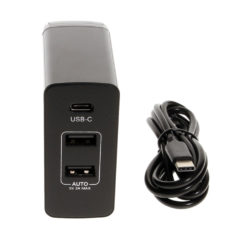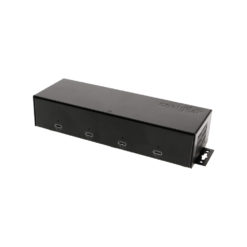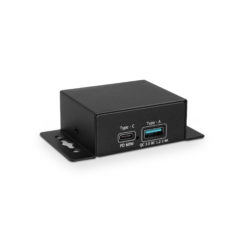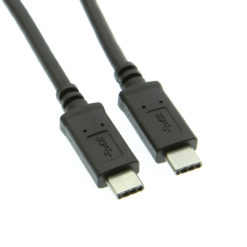What Is Fast Charging and Power Delivery?
When you look around today, you see USB being used to charge smartphones, digital cameras, and many other devices. In the past, keeping devices charged was a tricky and laborious task. Many devices came with their own dedicated AC adapters. These large “power bricks” would most often be very different from one another, using different connectors and wiring, and even required different power levels. It was very challenging, if not impossible, to use a single adapter to power multiple devices. You may remember the frustration as you searched for a misplaced adapter or going to your local electronics store and trying to choose the correct one from a large unorganized assortment or adapters. Travel was also cumbersome, as you have to arrange and pack multiple large adapters for each device.
USB Charging Standards
| Voltage | Current | Max Power | |
| USB 1.0 | 5V | 0.5A | 2.5W |
| USB 2.0 | 5V | 0.5A | 2.5W |
| USB 3.0 | 5V | 0.5A/0.9A | 4.5W |
| USB 3.1 (USB-C + USB-PD) | 5-20V | 0.5A/0.9A/1.5A/3A/5A | 100W |
USB Power Delivery
Today many devices charge or get their power from USB ports contained in laptops, cars, aircraft or even wall sockets. USB has become the standard power socket for many small devices such as cell phones, MP3 players and other hand-held devices. You need USB to fulfill your requirements not only in terms of data but also to provide power to, or charge, your devices simply, often without the need to load a driver, in order to carry out “traditional” USB functions.
USB Power Delivery enables the maximum functionality of USB by providing more flexible power delivery along with data over a single cable.
| Power output
(Operating Voltage and Current) |
0.5 – 15W | 15 – 27W | 27 – 45W | 45 – 60W | 60 – 100W |
| 5V | 0.1 – 3.0A | 3.0A (15W cap) | 3.0A (15W cap) | 3.0A (15W cap) | 3.0A (15W cap) |
| 9V | 1.67 – 3.0A | 3.0A (27W cap) | 3.0A (27W cap) | 3.0A (27W cap) | |
| 15V | 1.8 – 3.0A | 3.0A (45W cap) | 3.0A (45W cap) | ||
| 20V | 2.25 – 3.0A | 3.0 – 5.0A |
Benefits of USB Power Delivery
- More Power Increased power levels from existing USB standards up to 100W.
- Power Flows Both Ways Power direction is no longer fixed. This enables the product with the power (Host or Peripheral) to provide the power.
- Intelligent Power Negotiation Optimize power management across multiple peripherals by allowing each device to take only the power it requires, and to get more power when required for a given application.
- Increased Safety Carry increased wattage without being damaged or overheating
- Customizable Intelligent and flexible system-level management of power via optional hub communication with the PC.
- Works With Low Power Allows low power devices to negotiate for only the power they require.
Who is using USB Power Delivery?
Thanks to broad industry adoption, USB Power Delivery provides a universal charging solution for everything from phones to laptops.
- PD-Enabled Apple/iOS devices
- iPhone X, iPhone 8/8 Plus, iPad Pro
- MacBook and MacBook Pro
- PD-Enabled Android Devices
- Google Pixel 2, Google Pixel 2 XL
Qualcomm Quick Charging
Fast charging technologies are becoming increasingly common, and Quick Charge is one of the most frequently used. Qualcomm® Quick Charge technology powers your devices faster than conventional charging, allowing you to spend less time connected to outlets.
Each new Quick Charge generation is backwards compatible, meaning it will work with the generations that came before. In addition, Quick Charge 4+ is expected to work with USB Power Delivery, enabling Quick Charge accessories to fast charge a wider array of devices.
| Voltages | Max Current | Max Power | |
| Quick Charge 1.0 | 5V | 2A | 10W |
| Quick Charge 2.0 | 5 / 9 / 12V | 3A | 18W |
| Quick Charge 3.0 | 3.6 – 20V (200mV increments | 2.5 / 4.6A | 18W |
| Quick Charge 4.0+ | 3.6 – 20V (200mV increments) QC Mode
5 / 9V USB-PD Mode |
2.5 / 4.6A QC Mode
3A USB-PD Mode |
18W QC Mode
27W USB-PD Mode |
QC 3.0 and above also support the following protocols
- BC1.2
- MTK PE+1.1 and MTK PE+2.0
- Huawei Fast charge: FCP and SCP
- Samsung fast charge : AFC
- Spreadtrum fast charge : SFCP
Apple fast charging via USB-PD
The Apple iPhone XS, iPhone XS Max, iPhone XR, iPhone X, iPhone 8, and iPhone 8 Plus implement USB-PD, the same industry standard used by the iPad Pro, the 12-inch MacBook, Google’s Chromebook Pixel, and Lenovo’s X1 Carbon. Intercompatibility is its biggest advantage — USB-PD doesn’t require any special cables or wall adapters.
| Voltage | Current | Max Power | |
| USB-PD | 14.5V | 2A | 29W |
Quick Guide
- Defined by the USB 2.0 spec
- Typically found in desktop and laptop computers
- Capable of delivering up to 500mA (0.5A); with USB 3.0, it moves up to 900mA (0.9A)
- Higher current USB port
- Used for PCs, laptops, and other hardware
- Provides up to 1,500mA (1.5A)
- Power sources like wall warts and auto adapters
- Charging can occur with no digital communication
- Provides up to 1,500mA (1.5A)
- Can attach USB connector for charging
mAH, or Milliamp Hours, is the measure of the current carrying capacity of a battery. 1000mAH = 1AH.
It should be noted that mAH is not a good measure of the total capacity of a battery pack or charger. An 8,000mAH portable battery pack pack is large, but not uncommon or difficult to carry. However a 3.7v 8,000 mAH Lithium Ion battery has much less energy (total Watt hours) than a 12v 8,000mAH battery, such as what you might find in a common battery backup or alarm system. The LION battery is 30 Watt-hours, while the larger 12v battery is 96 Watt-Hours, but both are 8AH. Watt-hours = milliamp-hours × volts / 1000
A 1AH battery can provide 1A of current for 1 hour, or 2A for 30 minutes. 0.5 for 2 hours, etc. In the real world batteries lose voltage as their capacity drops, which means the current rises to compensate, so this should only be used as a “rule of thumb“.
Short for voltage, volts indicates the willingness for electricity to flow. Voltage overcomes resistance in wiring. The higher the voltage(V), the lower the current(A) needed to carry the same power(W), and the smaller the wiring can be.
In using the ‘water through a pipe’ analogy, voltage is the pressure of the water in the pipe.
Short for ampere, it is the a unit of measure for current. Amps can be thought of as the measure of flow of electrons moving through a circuit.
In the ‘water through a pipe’ analogy, amps are the volume of water flowing through the pipe.
Watts is the total measure of “power”, or work that can be done. It is calculated simply as: Volts x Amps = Watts
A smaller current (A) can do the same the same amount work (W) by increasing the voltage (V).
A practical example: devices are often given power ratings by their manufacture in Watts. USB is (unless explicitly stated otherwise) 5 volts, so a 5 watt device will draw 1 amp because if V x A = W, then W / V = A. A 10w device would draw 2A, and so on.

























